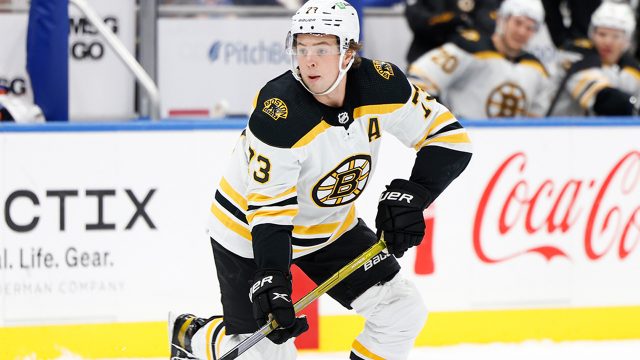With the all-star break underway, we can look back at some of the top defence pairs of the 2021-22 season so far.
Just like we did with the best lines around the league, we’re not only going to focus on the leading duos around the league. Instead, we’ll go down the lineup to analyze some of the top defensive pairs of their position.
Our criteria is pretty broad. Ideally, there’s some longevity; the search excluded all pairs below 100 minutes of experience. The combination also has to be active — it can’t be one that coaches broke apart, even if they had hundreds of minutes of play before hand. And of course, they have to perform well both at and below the surface level.
Let’s dive in.
[snippet id=5216510]
First pair
Matt Grzelcyk – Charlie McAvoy
After a couple games apart due to injury, the Bruins’ top pair is back together. With just under 300 minutes of 5-on-5 ice time, they get points for longevity. But above all else, it’s what they do in those minutes.
In Grzelcyk, there’s a more offensively inclined skater with stick handling skills, who can send his teammates a stretch pass and exit the defensive end with control. Then there’s McAvoy who denies entries against, blocks passes, helps break the puck out, and can jump up into the offence.
Boston doesn’t just tilt the ice in terms of shots while they’re on the ice — they generate quality chances that contribute to an expected goals rate of about 66 per cent. Among all defenders with 100 minutes of 5-on-5 play, few are on the ice for as high of a rate of offence as this pairing, with 4.03 expected goals for per 60. Plus, they’re solid in their own end, only conceding 2.08 expected goals against. Then, there’s the results; the Bruins have out-scored their opponents 22-9 with them on the ice for a 71 per cent goals rate.
There are quite a few leading duos worth highlighting. Aaron Ekblad and MacKenzie Weegar picked up right where they left off when Ekblad was injured last season. There’s a familiarity with this duo between their seasons of experience, and ~690 minutes of 5-on-5 play this season – only three pairs have played together longer in 2021-22. Their two-way efforts are clear below the surface, with a 60.5 per cent expected goals rate and a close actual scoring rate.
Also impressive: Cale Makar and Devon Toews. They’re another pair with two Norris-calibre players who help their team on both ends of the ice. The results for this duo stand out in particular, with their high 71 per cent goals rate. Plus, Noah Hanifin and Rasmus Andersson deserve a shoutout for their efforts in Calgary and longevity (632 minutes).
Second Pair
Oliver Kylington – Chris Tanev
The Flames haven’t had to mix and match their top-four defenders much. Hanifin and Andersson have settled into that top pair while Kylington and Tanev are mainstays right below them, with about 600 minutes of 5-on-5 play. That first pair is generally the duo leaned on against ‘top’ competition, but having such a strong second pair right below them has boosted this blue line.
Tanev’s a very defensive defenceman. Teams aren’t able to generate much off the rush while he’s deployed; he jumps on loose pucks even when there’s pressure and protects the quality areas of the ice. Kylington, on the other hand, is breaking out this season because of his two-way play. He helps to deny opponents from entering the offensive zone, and can successfully make an outlet pass to turn play around which gets his team generating more chances off the rush when he’s on the ice.
Calgary maintains just under 60 per cent of the expected goal share while this duo is deployed. Their offensive efforts help the team generate quality chances at an above average rate. But what really stands out is just how much they limit their opponents — to an expected goal rate of just 1.94 per 60. Their goaltenders feel that support and help their goals percentage match closely with expectations.
Third Pair
Pittsburgh’s found a third pair it can trust in Matheson and Ruhwedel, which is why they’ve played over 430 minutes together at 5-on-5. The team’s broken even in goals with them on the ice — 20 for, and a matching 20 against — but hasn’t always had the best luck, either. The Penguins’ save percentage with them on is an .895. But thanks to their level of play together, the team’s expected to be closer to a 58 per cent goals share.
Ruhwedel is a more physical, defensive defender. He stops opponents from crossing the blue line into Pittsburgh’s defensive zone, limits rush chances against, and doesn’t shy away from physical play.
Matheson’s having what may be his best season in Pittsburgh. USA defender Emily Pfalzer’s husband seems to be finding more consistency in his game this year, and the Penguins are helping keep him in a position to have success at even strength. He can block passes, use his stick to disrupt opponents’ chances, and on the other end of the ice, help bring the puck into the O-zone with control. Plus, Matheson can contribute to the Penguins’ offensive generating plays, including sending stretch passes to spring his teammates for rush chances.
Their skill sets help the Penguins exceed expectations slightly with their offensive creation and rank highly among other defensive pairs in scoring chance suppression. The team concedes juts 1.97 expected goals against while they’re on the ice.
This pair may not be asked to play the toughest shutdown minutes in a game, but have become a reliable duo that the Penguins can rely on, and comfortably roll three pairs which has solidified their blue line.
Data via Sportlogiq
[relatedlinks]
